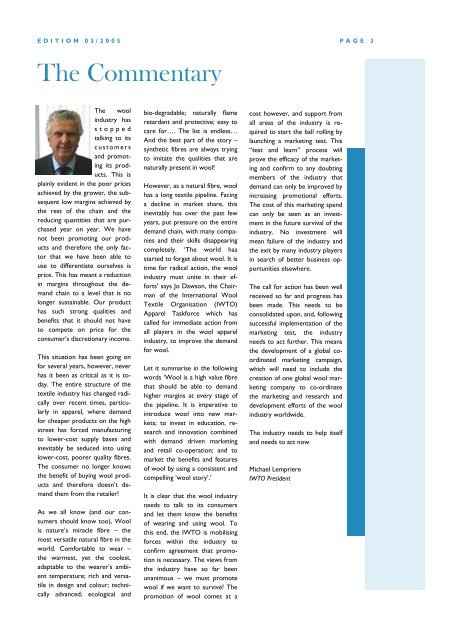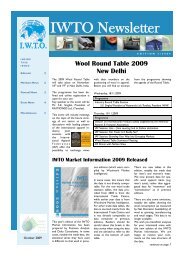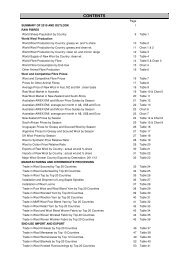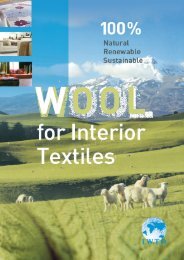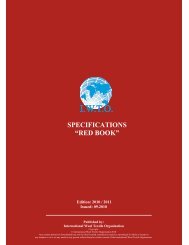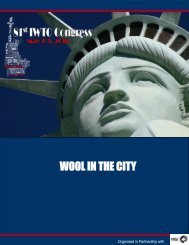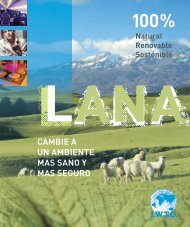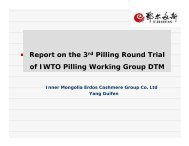You also want an ePaper? Increase the reach of your titles
YUMPU automatically turns print PDFs into web optimized ePapers that Google loves.
EDITION 03/2005<br />
The Commentary<br />
PAGE 3<br />
The wool<br />
industry has<br />
stopped<br />
talking to its<br />
customers<br />
and promoting<br />
its products.<br />
This is<br />
plainly evident in the poor prices<br />
achieved by the grower, the subsequent<br />
low margins achieved by<br />
the rest of the chain and the<br />
reducing quantities that are purchased<br />
year on year. We have<br />
not been promoting our products<br />
and therefore the only factor<br />
that we have been able to<br />
use to differentiate ourselves is<br />
price. This has meant a reduction<br />
in margins throughout the demand<br />
chain to a level that is no<br />
longer sustainable. Our product<br />
has such strong qualities and<br />
benefits that it should not have<br />
to compete on price for the<br />
consumer’s discretionary income.<br />
This situation has been going on<br />
for several years, however, never<br />
has it been as critical as it is today.<br />
The entire structure of the<br />
textile industry has changed radically<br />
over recent times, particularly<br />
in apparel, where demand<br />
for cheaper products on the high<br />
street has forced manufacturing<br />
to lower-cost supply bases and<br />
inevitably be seduced into using<br />
lower-cost, poorer quality fibres.<br />
The consumer no longer knows<br />
the benefit of buying wool products<br />
and therefore doesn’t demand<br />
them from the retailer!<br />
As we all know (and our consumers<br />
should know too), Wool<br />
is nature’s miracle fibre – the<br />
most versatile natural fibre in the<br />
world. Comfortable to wear –<br />
the warmest, yet the coolest,<br />
adaptable to the wearer’s ambient<br />
temperature; rich and versatile<br />
in design and colour; technically<br />
advanced; ecological and<br />
bio-degradable; naturally flame<br />
retardant and protective; easy to<br />
care for…. The list is endless…<br />
And the best part of the story –<br />
synthetic fibres are always trying<br />
to imitate the qualities that are<br />
naturally present in wool!<br />
However, as a natural fibre, wool<br />
has a long textile pipeline. Facing<br />
a decline in market share, this<br />
inevitably has over the past few<br />
years, put pressure on the entire<br />
demand chain, with many companies<br />
and their skills disappearing<br />
completely. ‘The world has<br />
started to forget about wool. It is<br />
time for radical action, the wool<br />
industry must unite in their efforts’<br />
says Jo Dawson, the Chairman<br />
of the International Wool<br />
Textile Organisation (<strong>IWTO</strong>)<br />
Apparel Taskforce which has<br />
called for immediate action from<br />
all players in the wool apparel<br />
industry, to improve the demand<br />
for wool.<br />
Let it summarise in the following<br />
words ‘Wool is a high value fibre<br />
that should be able to demand<br />
higher margins at every stage of<br />
the pipeline. It is imperative to<br />
introduce wool into new markets;<br />
to invest in education, research<br />
and innovation combined<br />
with demand driven marketing<br />
and retail co-operation; and to<br />
market the benefits and features<br />
of wool by using a consistent and<br />
compelling ‘wool story’.’<br />
It is clear that the wool industry<br />
needs to talk to its consumers<br />
and let them know the benefits<br />
of wearing and using wool. To<br />
this end, the <strong>IWTO</strong> is mobilising<br />
forces within the industry to<br />
confirm agreement that promotion<br />
is necessary. The views from<br />
the industry have so far been<br />
unanimous – we must promote<br />
wool if we want to survive! The<br />
promotion of wool comes at a<br />
cost however, and support from<br />
all areas of the industry is required<br />
to start the ball rolling by<br />
launching a marketing test. This<br />
“test and learn” process will<br />
prove the efficacy of the marketing<br />
and confirm to any doubting<br />
members of the industry that<br />
demand can only be improved by<br />
increasing promotional efforts.<br />
The cost of this marketing spend<br />
can only be seen as an investment<br />
in the future survival of the<br />
industry. No investment will<br />
mean failure of the industry and<br />
the exit by many industry players<br />
in search of better business opportunities<br />
elsewhere.<br />
The call for action has been well<br />
received so far and progress has<br />
been made. This needs to be<br />
consolidated upon, and, following<br />
successful implementation of the<br />
marketing test, the industry<br />
needs to act further. This means<br />
the development of a global coordinated<br />
marketing campaign,<br />
which will need to include the<br />
creation of one global wool marketing<br />
company to co-ordinate<br />
the marketing and research and<br />
development efforts of the wool<br />
industry worldwide.<br />
The industry needs to help itself<br />
and needs to act now.<br />
Michael Lempriere<br />
<strong>IWTO</strong> President


